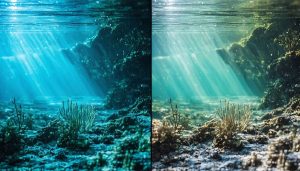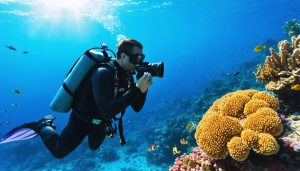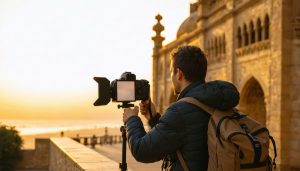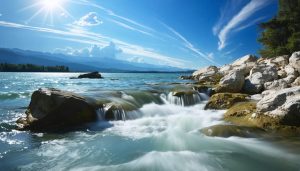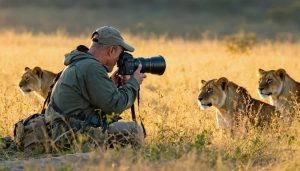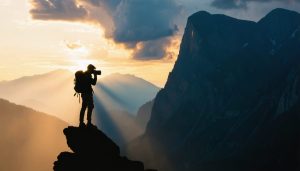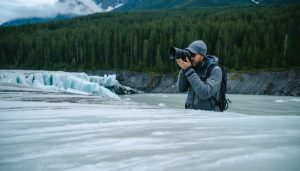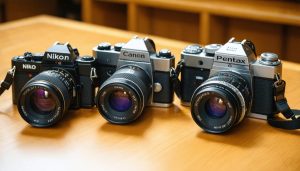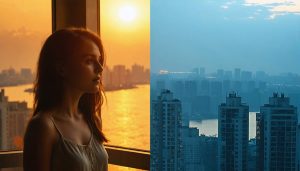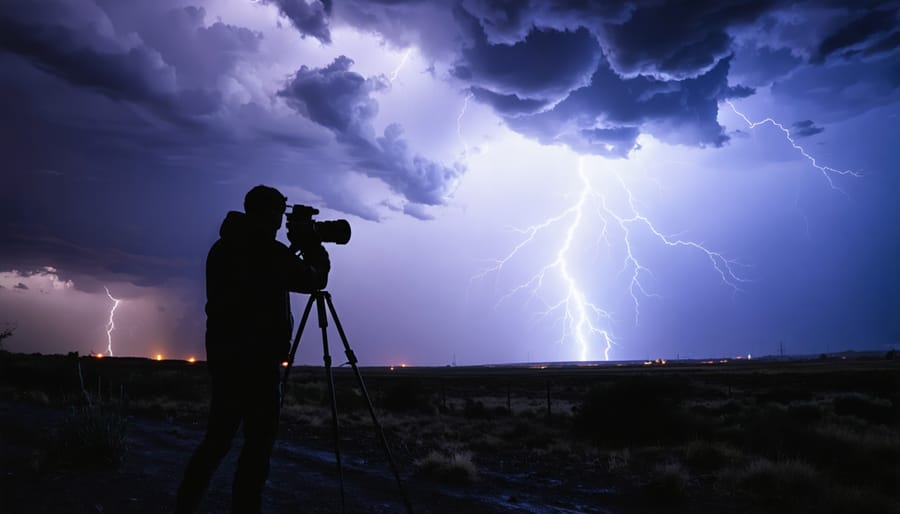
Lightning splits the sky as a supercell thunderstorm churns across the Great Plains. Capturing nature’s most dramatic moments demands equal parts technical mastery, raw courage, and meticulous preparation. Beyond mastering fundamental photography skills, extreme weather photographers navigate a high-stakes dance between getting the perfect shot and maintaining absolute safety.
Standing before a tornado or tracking hurricane-force winds requires specialized equipment, advanced forecasting knowledge, and split-second decision-making. Professional storm chasers spend years honing their craft, learning to read atmospheric conditions, and developing an intimate understanding of weather patterns that most photographers never encounter.
Yet the rewards of extreme weather photography extend far beyond stunning portfolio pieces. These images serve as powerful documentation of our changing climate, educational tools for meteorologists, and windows into nature’s raw power that most people will never witness firsthand. Whether capturing the ethereal beauty of lightning, the destructive force of a tornado, or the otherworldly formations of severe storms, extreme weather photography combines technical expertise with primal human fascination in nature’s most dramatic moments.
Join us as we explore the essential techniques, safety protocols, and equipment needed to capture these awe-inspiring phenomena while maintaining the utmost respect for nature’s devastating potential.
Essential Gear for Extreme Weather Photography
Weather-Sealed Camera Bodies and Lenses
When shooting in extreme weather conditions, your camera gear needs to be as resilient as your determination. Weather-sealed equipment is your first line of defense against the elements, offering crucial protection for your valuable gear.
Professional-grade camera bodies typically feature comprehensive weather sealing, with rubber gaskets and seals around buttons, dials, and compartment doors. Look for cameras rated as “weather-resistant” or “weather-sealed,” but remember that these designations don’t mean completely waterproof. Popular options include the Canon EOS R5, Nikon Z6 II, and Sony A7R IV, all known for their robust weather protection.
Your lens choice is equally important, if not more so. Weather-sealed lenses feature additional gaskets around the mount, focus ring, and zoom mechanism. When paired with a weather-sealed body, they create a protective barrier against moisture, dust, and freezing temperatures. However, this protection is only effective when both body and lens are weather-sealed – using a non-sealed lens on a sealed body creates a weak point where elements can enter.
For added protection, consider using clear filters on your lenses and carrying silica gel packets in your camera bag. While weather sealing adds to equipment cost, it’s an investment that pays off when capturing those dramatic storm clouds, snow-capped peaks, or monsoon rains. Just remember that even the best weather sealing has its limits – always use common sense and additional protection like rain covers in extreme conditions.
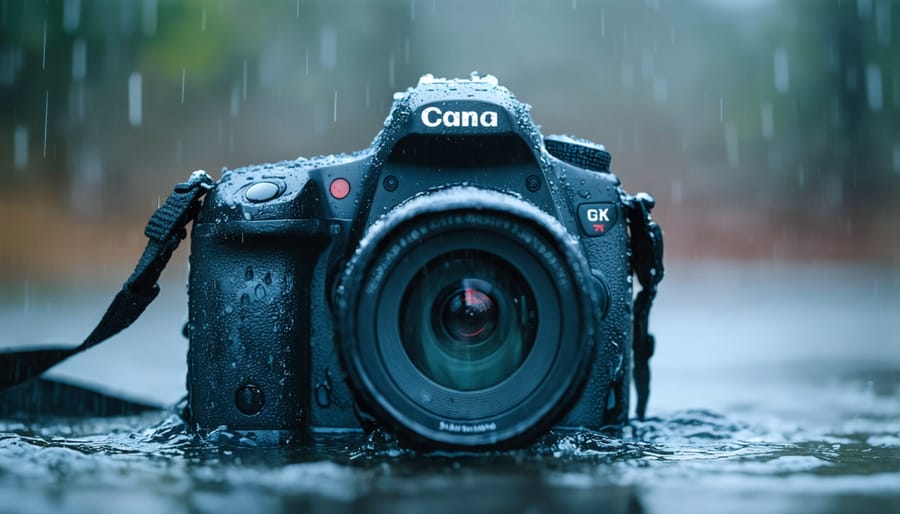
Protective Equipment and Accessories
When shooting in extreme weather conditions, your gear needs as much protection as you do. A quality rain cover is essential – look for ones made from durable, waterproof materials with sealed seams and easy access to camera controls. Consider neoprene covers for cold weather conditions, as they provide both water resistance and insulation.
Filters play a crucial role in protecting your expensive lenses. UV filters are your first line of defense against moisture, sand, and flying debris. For shooting in snow or near water, a circular polarizing filter helps manage glare and enhances color saturation. In dusty conditions, clear protective filters are invaluable – just remember to pack multiple ones, as they may need frequent cleaning or replacement during shoots.
Don’t forget about your camera bag. Weather-sealed bags with multiple compartments help organize and protect your gear while providing quick access. Many photographers swear by silica gel packets to combat humidity – pack several in your bag and replace them regularly. For extreme cold, battery pouches with insulation are essential, as cold temperatures can dramatically reduce battery life.
Additional accessories to consider include lens hoods (which protect against rain and snow while reducing lens flare), microfiber cloths for wiping away moisture, and a robust camera strap that won’t deteriorate in harsh conditions. Waterproof memory card cases protect your valuable images, while a rain sleeve for your tripod prevents rust and ensures smooth operation.
For those shooting in particularly challenging conditions, consider investing in a storm jacket for your camera – these specialized covers provide comprehensive protection while maintaining access to all controls. Some photographers also use hand warmers strategically placed in their camera bags to prevent condensation in cold environments.
Remember, your gear protection strategy should be tailored to your specific shooting environment. What works in a tropical storm might not be suitable for a desert sandstorm, so research and prepare accordingly.
Safety First: Preparing for Extreme Weather Shoots
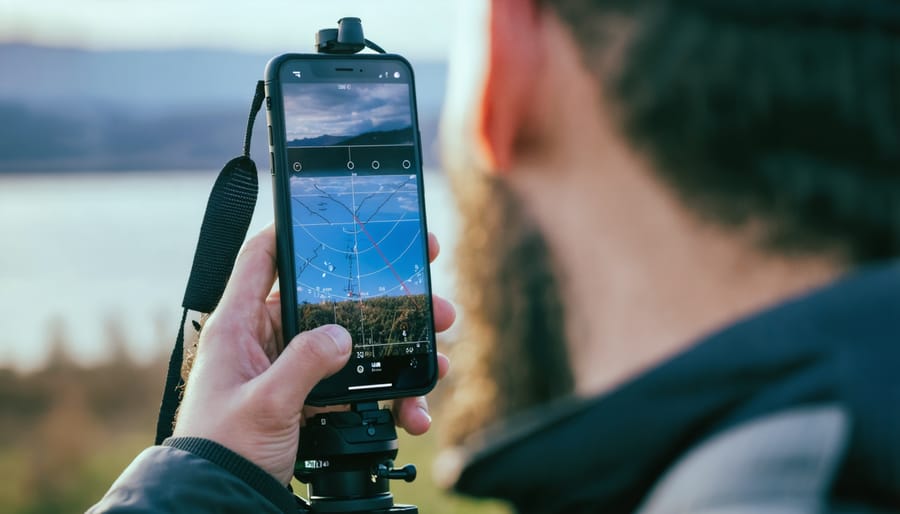
Weather Monitoring and Planning
Successful extreme weather photography starts with careful monitoring and planning. Professional photographers rely on a combination of traditional weather forecasting tools and mobile weather monitoring apps to track developing conditions and make informed decisions about shooting locations and timing.
Begin by establishing multiple reliable weather information sources. Local meteorological services, radar maps, and satellite imagery provide crucial data about storm movements and intensity. Pay special attention to wind speed, precipitation patterns, and lightning strike frequency when tracking severe weather systems.
Create a checklist of weather indicators that signal optimal shooting conditions for your target phenomenon. For storm photography, watch for supercell development and wall clouds. For lightning, monitor the buildup of cumulonimbus clouds and track storm movement using radar.
Always plan multiple escape routes and safe shelter locations before heading out. Identify elevated areas for flood-prone regions and sturdy buildings in tornado-prone zones. Keep your vehicle facing your exit route and maintain a full tank of gas.
Set personal safety thresholds – specific wind speeds, visibility distances, or lightning proximity – beyond which you’ll cease shooting and seek shelter. Remember that no photo is worth risking your safety. Give yourself plenty of time to reach shelter before conditions become dangerous, and always inform someone about your planned location and expected return time.
Emergency Protocols and Equipment
When photographing extreme weather, your safety equipment is just as crucial as your camera gear. Always carry a well-stocked emergency kit containing a first-aid kit, flashlight with extra batteries, emergency blanket, and multi-tool. Keep a fully charged mobile phone and portable battery pack in a waterproof case, and store emergency contact numbers where they’re easily accessible.
Weather-appropriate clothing is essential: pack waterproof and windproof outer layers, thermal undergarments, and extra warm socks. Carry hand warmers and protective gear like safety goggles and a hard hat, especially when photographing storms or hurricanes.
Establish clear emergency protocols before heading out. Share your planned location and expected return time with at least two trusted contacts. Research and save the contact information for local emergency services, and familiarize yourself with the nearest shelter locations or safe buildings.
Keep a small emergency shelter in your vehicle, such as a pop-up tent or tarp, along with non-perishable food and water for at least 24 hours. A battery-powered weather radio can provide crucial updates when cell service fails.
Remember the “30-30 Rule” for lightning: if the time between lightning and thunder is less than 30 seconds, seek shelter immediately and wait 30 minutes after the last thunder before resuming photography. Always prioritize personal safety over getting the perfect shot – no photograph is worth risking your life.
Shooting Techniques for Different Weather Conditions
Lightning and Storm Photography
Capturing lightning and storms requires a combination of technical skill, patience, and careful timing. To start, you’ll need a sturdy tripod, a camera capable of manual settings, and ideally, a weather-sealed lens. The key to successful storm photography lies in mastering long exposures and understanding dramatic lighting techniques.
Set your camera to manual mode and start with these baseline settings: ISO 100, f/8 aperture, and a shutter speed between 5-30 seconds. The longer exposure allows you to capture multiple lightning strikes in a single frame, creating more dramatic compositions. Using a remote trigger or cable release helps prevent camera shake during these extended exposures.
Composition is crucial in storm photography. Include foreground elements like buildings or landscapes to provide scale and context to the lightning. The rule of thirds works particularly well here – try positioning the horizon in the lower third of the frame to emphasize the dramatic sky above.
Focus can be tricky in low light conditions. Switch to manual focus and set your lens to infinity, then make minor adjustments as needed. If possible, pre-focus on a distant object while there’s still enough light.
For optimal results, shoot in RAW format to preserve maximum detail in both highlights and shadows. This gives you more flexibility during post-processing to balance the extreme contrast between the bright lightning and dark storm clouds.
Safety should always be your primary concern. Never shoot in open areas during a storm, and always maintain a safe distance. A covered position like a car or building with a clear view of the storm offers the best combination of safety and photographic opportunity.
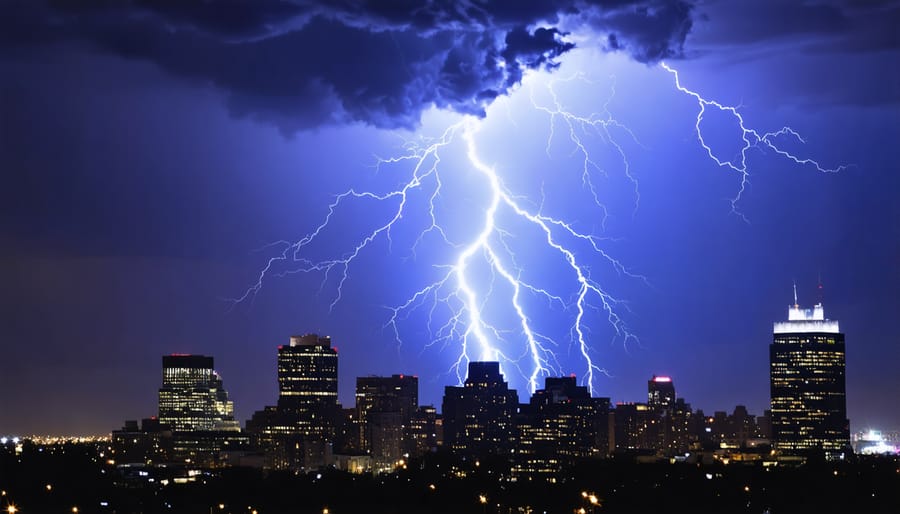
Blizzards and Extreme Cold
Capturing stunning images in blizzard conditions and extreme cold presents unique challenges that require careful preparation and specialized techniques. Your camera gear needs protection from moisture and freezing temperatures just as much as you do. Start by using neoprene lens covers and keeping spare batteries close to your body, as cold temperatures can quickly drain battery life.
When shooting in snow, your camera’s light meter can be easily fooled by the bright white conditions. Typically, you’ll need to overexpose by 1-2 stops to prevent snow from appearing gray in your images. Using your camera’s histogram is crucial – aim for the data to be slightly right of center without clipping the highlights.
Keep your gear transitions gradual to prevent condensation. When moving between temperature extremes, seal your equipment in airtight bags before entering warm environments. This allows your gear to adjust slowly and prevents moisture from forming on sensitive electronics.
Focus on capturing the drama of the storm – falling snow, wind-blown drifts, and ice formations can create compelling compositional elements. Use faster shutter speeds (1/250 or higher) to freeze individual snowflakes, or slower speeds to create ethereal streaks of snow. A lens hood is essential not just for preventing lens flare, but also for keeping snow off your front element.
Consider using manual focus, as autofocus systems can struggle in heavy snowfall. If shooting in active blizzard conditions, position yourself with your back to the wind when possible to minimize snow hitting your lens. Most importantly, always carry backup gear and keep shooting sessions brief to protect both yourself and your equipment from the extreme elements.
Tornadoes and High Winds
Capturing the raw power of tornadoes and severe winds requires a delicate balance between getting the shot and maintaining personal safety. The key is to maintain a respectful distance – typically at least a mile from a tornado – while using appropriate equipment to document these extraordinary phenomena.
A sturdy tripod is absolutely essential, as high winds can make handheld shooting nearly impossible. Look for heavy-duty models with wide leg spreads and hook attachments for hanging additional weight. Weather-sealed cameras and lenses are non-negotiable in these conditions, as blowing debris and rain can quickly damage unprotected gear.
For maximum safety, consider implementing remote photography techniques using weather-protected camera triggers or drone technology when conditions permit. This allows you to capture dramatic shots while maintaining a safer distance from the severe weather.
When composing your shots, include foreground elements to provide scale and context – trees bending in the wind, flying debris, or storm-damaged structures can all add dramatic impact. Wide-angle lenses (16-35mm) are excellent for capturing the full scope of the storm, while telephoto lenses (70-200mm) allow you to zoom in on specific details from a safe distance.
Camera settings for wind events typically include:
– Fast shutter speeds (1/500 sec or faster) to freeze motion
– Medium to small apertures (f/8-f/11) for adequate depth of field
– ISO 400-800 to maintain quick shutter speeds in darker conditions
– Continuous shooting mode to capture rapid changes
Always work with a trained storm spotter or chase team, and never attempt to photograph severe weather alone. Keep multiple escape routes in mind, and constantly monitor weather updates and radar data. Remember that no photograph is worth risking your safety – if conditions become too dangerous, it’s time to seek shelter immediately.
Post-Processing Weather Photography
Enhancing Drama While Maintaining Authenticity
In the digital age, the temptation to dramatically enhance weather photos can be strong, but there’s a fine line between impactful editing and maintaining authenticity. The key to successful storytelling through weather photography lies in subtle adjustments that amplify nature’s drama without crossing into unrealistic territory.
When editing extreme weather photos, start with basic adjustments to exposure, contrast, and clarity. These fundamental tweaks can help emphasize the power of storm clouds or the intensity of lightning without compromising the image’s integrity. Pay particular attention to the highlights and shadows – dramatic weather often creates stark lighting conditions that may need careful balancing.
Color manipulation requires a especially delicate touch. While it’s tempting to push saturation to emphasize dramatic skies, excessive color enhancement can quickly make your images look artificial. Instead, work with selective color adjustments, focusing on specific elements like the blues in storm clouds or the warm tones of sunset-lit tornado formations.
Local adjustments are your best friends when enhancing weather photos. Use graduated filters to balance bright skies with darker foregrounds, or employ careful dodging and dodging to direct attention to key elements like lightning strikes or forming funnel clouds. The goal is to guide the viewer’s eye while maintaining the natural feel of the scene.
Remember that the most compelling weather photos often need minimal enhancement – nature provides plenty of drama on its own. If you find yourself making extreme adjustments, step back and ask whether you’re serving the truth of the moment or creating something that exists only in digital space.
Consider maintaining multiple versions of your edits: one that pushes the dramatic elements for impact, and another that stays closer to the original capture. This approach allows you to choose the most appropriate version for different contexts while preserving the authentic documentation of the weather event.
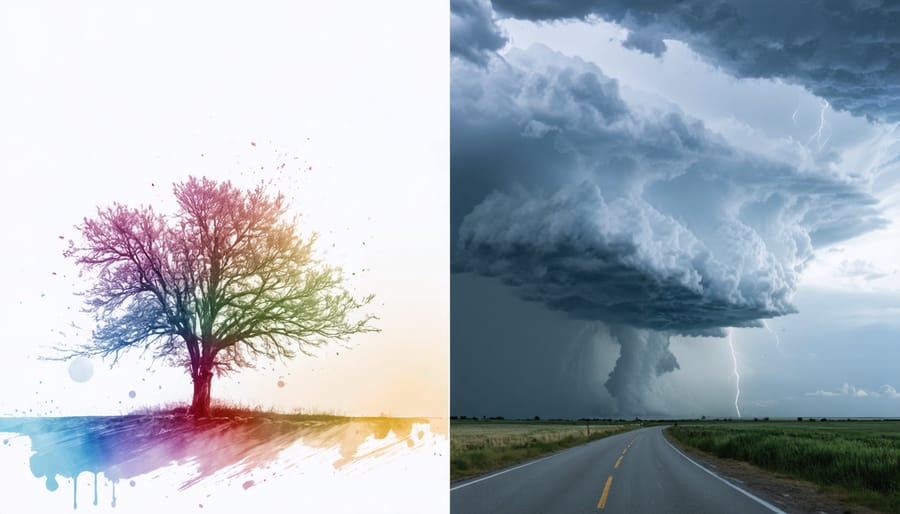
Extreme weather photography offers some of the most spectacular opportunities to capture nature’s raw power and beauty. Throughout this guide, we’ve explored the essential elements of successfully photographing storms, lightning, blizzards, and other dramatic weather phenomena. From selecting the right gear and protective equipment to mastering specialized techniques for different weather conditions, you now have the foundational knowledge to begin your journey into extreme weather photography.
Remember that while capturing these awe-inspiring moments can be thrilling, your safety should always be your top priority. Never compromise your well-being for a shot, no matter how promising it might seem. Always check weather forecasts, maintain awareness of your surroundings, and have an escape route planned. Working with experienced storm chasers or joining photography groups can provide valuable mentorship and added safety.
As you venture into extreme weather photography, start gradually and build your experience. Practice your techniques in milder conditions before tackling more challenging scenarios. Keep your gear protected, your batteries charged, and your weather apps updated. Most importantly, continue learning and adapting your approach based on experience.
With patience, preparation, and respect for nature’s power, you’ll be well-equipped to capture extraordinary weather events while staying safe. The skills you develop will not only help you create stunning images but also foster a deeper appreciation for the incredible forces that shape our natural world.

